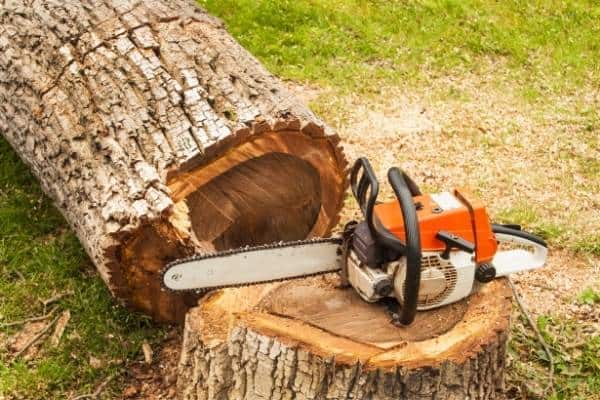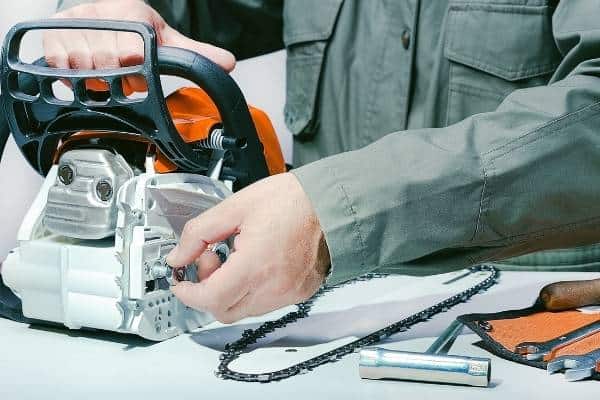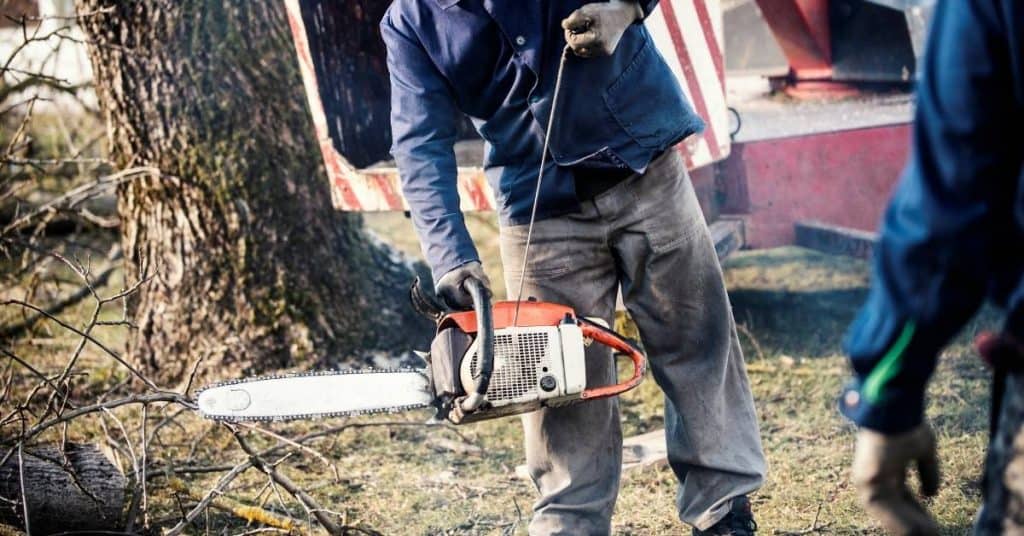A chainsaw is an invaluable tool for the home and professional user alike. It can carry out a wide variety of tasks, from felling a tree to cutting firewood. However, chainsaws are not perfect machines, and they do break down from time to time. The chainsaw won’t start if it has been in use or storage for too long without being properly maintained (e.g., changing the oil).
Many other potential causes could prevent your chainsaw from starting up when you need it most. Fortunately, there are some simple troubleshooting steps you can take to get your saw running again. This article will outline these steps so that next time your chainsaw gives up on you, you’ll know what to do.
What Causes a Chainsaw to Not Start?
- It is in OFF position
- Not Getting Any Fuel
- Bad Fuel
- Spark Plug Issues
- Bad or Clogged Carburetor
- Igniton Coil Needs Replacing
- Defective or Damaged Recoil Starter
- Fuel Filters or Air Filters Need Cleaning
- Weak Compression Seal or Piston Seal
- Defective recoil starter
- Too Hot or Too Cold
- Flooded Engine
- Needs Basic Maintenance
Basic mechanics of a chainsaw
First, let’s go over some basic mechanics of how a chainsaw engine works. We can then go into different reasons the chainsaw may not be starting or stay running.

A chainsaw is a portable saw with a small gas-powered engine that drives the chains. The chains are connected to a long sharp cutting edge, and they are used to cut through wood. Chainsaw chains have a grooved pattern that allows them to grip the wood as it is cut. Chainsaws can be gas-powered or battery-powered. They also have different attachments for specialized performance and convenience.
A chainsaw is started by pulling a cord attached to the starter mechanism on the engine of the chainsaw. When the chainsaw’s operator pulls the starter cord (or presses the “easy start” button), it yanks out a section of rope, which then spins around inside the chainsaw until it is fed into the spark plug at one end of the chainsaw slot. The spark plug fires, igniting the fuel and air mixture in the combustion chamber, and energy is released, causing the piston to go back and forth. When the clutch is engaged, this will cause the chains to move in a circular motion, and they will start spinning very fast around the long bar.
How to Properly Start A Chainsaw
- Stablize the Chainsaw- place it flat on the ground. Check fuel supply and chain tension. Be sure chainsaw is away from all obstacles.
- Check the Chain Brake- Make sure it activated. The Chain brake stops movement of the chain around the saw’s guide bar.
- Open the Choke and press the fuel primer until you see fuel in the bulb. The choke is what regulates the air-fuel mixture to the engine.
- Pull the starter rope- make sure to hold the saw’s upper handle down while using the other hand to pull up on the starter cord. It may take a few pulls before the engine turns over.
- Push the throttle halfway- Once the engine turns over push the choke in halfway and pull the rope again, once the engine runs, push the choke to the run position and let the engine idle to warm up.
Troubleshooting the Reasons Your Chainsaw Won’t Start
Now that you know the basic mechanics of how a chainsaw works and the proper way to start a chainsaw, let’s troubleshoot. Here we will dive deeper into why it may not be starting and how you can fix it.
1. Chainsaw is Not Getting Any Fuel or Bad Fuel
One of the main issues with a hard start or a non-starting chainsaw is fuel issues. Your gas may be bad. Gasoline starts to go bad immediately after you purchase it. The ethanol that is added to most fuels attracts water, which can cause it to go bad. Try purchasing ethanol-free gas to add to your chainsaw.
Another reason your chainsaw may not be getting any fuel is the chainsaw may have air in the fuel line. You can test this by inserting a hose into the chainsaw’s fuel valve and turning on the chainsaw. If you notice bubbles coming up through the hose, there is some air trapped in the fuel line.
To get rid of the air, turn off the chainsaw and disconnect it from any power source- including removing all spark plugs if it has plug-and-play. Next, use a tire pump or a compressor to push as much air out of the chainsaw as possible until no more air comes out of the chainsaw.
Refill with fresh fuel, reconnect the fuel line to fill the tube with fuel so there are no air bubbles. This should allow the chainsaw to start and run as normal. Go through the steps above to properly start a chainsaw.
2. Too Hot or Cold for Chainsaw to Start
Some chainsaws have a compression release mechanism that stops the chainsaw from starting if it’s too cold or hot. This can be due to something as simple as the chainsaw being too cold outside. To see if this is the problem, remove the spark plug wire from the chainsaw’s spark plug, then try to start it again. If the chainsaw still won’t start, this means that there is not enough compression to power the chainsaw, and you will need to turn off your chainsaw and let it cool down or warm up if it is too cold out.
3. Chainsaw is Over-Heating
A chainsaw is prone to over-heating. This can happen when you are using the chainsaw for a long period of time without giving it a chance to cool down. This can also happen if you are trying to cut thick logs or branches. If your chainsaw has overheated and shut off, then it won’t start again; you need to let the chainsaw cool down for 10 minutes.
If you are trying to cut thick logs, you may need to take short breaks and let the chainsaw cool down in between each cut. You may also need to lubricate your chainsaw. When using for an extended period of time, your chainsaw oil may become gummed up. Be sure to check the oil level after big cuts.
4. Spark Plug Issues
Another common cause of a chainsaw not starting is a faulty spark plug. The chainsaw is powered by a spark plug, which may have gone defective or been incorrectly fitted. There are two types of plugs; the resistor and the contact type.
Resistor-type plugs have a thick center that resists electricity from escaping when it is not in use. These plugs work best for chainsaws that don’t make heavy use of the chainsaw chains, such as those used for pruning trees or hedges.
On the other hand, Contact-type spark plugs have an electric conductor inserted into their center that emits sparks when it touches an electrified wire. These wires can break off inside the chainsaw shaft if they are too thin, and then the chainsaw will not start.
Check with your manual for the right spark plug replacement. Replace the spark plug, and your chainsaw should start right up.
5. Bad or Clogged Carburetor
A bad carburetor can prevent chainsaws from starting. This is a problem with the chainsaw’s engine and can be often be caused by fuel contamination or overuse. You could clean it due to a clog. To clean the carburetor, you need to drain the fuel and spray the carburetor with a cleaning spray. Then add new fuel, making sure it is ethanol-free.
If cleaning the carburetor did not work, it may need to be replaced. To replace, you can purchase a new one according to the model # you need and follow the manufacturer’s instructions, or you can take it to a service repair shop.
6. Ignition Coil Defective or Needs Replacing
When chainsaws don’t start, the problem can be as simple as tightening a gas line or spark plug. However, chainsaws also have ignition coils that can fail. Common signs of a bad ignition coil are backfiring, rough idle, poor power, and a hard-to-start engine. When an ignition coil fails, it will need to be replaced to start a chainsaw. The chainsaw will need to be disassembled, and then You can replace the ignition coils.
7. Fuel Filters Need to be Cleaned
When chainsaws don’t start, it can sometimes be due to a dirty fuel filter that needs to be cleaned. Fuel filters are usually located where the gas line connects with the chainsaw chains and can get clogged with dirt. A chainsaw will not start if it cannot be supplied with fuel, so a blocked fuel filter may cause chainsaws to stop working altogether. If you are having trouble starting your chainsaw, you should first check the fuel filter for any blockages.
8. Recoil Starter Is Defective
The chainsaw could have a defective recoil starter. This is the device that pulls on the chainsaw cord to create enough force to start the chainsaw. The pulley may be damaged or pulled from its housing, which would prevent recoil from springing back and pulling on the chainsaw cord over the flywheel. Or, there may be a malfunction with the starter cord itself due to being old and worn out. Look at your manual on how to open the housing and see what may be damaged.
9. Weak Compression Seal or Piston Seal
Occasionally chainsaws will not start because of a weak compression seal or piston seal. First, take the chainsaw to the ground and try to lift it with the starter rope. Good compression will prevent the rope from pulling out. If the rope starts extending as you lift it, you most likely have low compression.
Damage to the piston rings can cause low compression. There can also be an air leak on the crankshaft seals. Remove the exhaust to check for piston ring damage. Always refer to your owner’s manual for instructions on how to do this.
10. Chainsaws Require Routine Maintenance

Chainsaws often require some routine maintenance before use. You should always check chainsaw chains to ensure they are tight, the chainsaw bar for bent or damaged links, and the chainsaw chain tension adjustment screw to ensure it is free of rust and not too loose or too tight. When chainsaws are just sitting around not being used, chains can start to rust and get dirty.
You should also ensure your chainsaw has a clean air filter and fully charged battery or clean fuel to get the most out of your chainsaw. It’s also good practice to regularly change your chainsaw’s oil (at least once every year) and use it per all manufacturer recommendations.
A chainsaw works by cutting wood via the teeth of the chain. If your chainsaw’s chains are missing teeth or have a dirty chainsaw blade, the chainsaw may not cut through wood effectively and become damaged.
It is a good idea to take a metal wire brush to the chains so that you can remove any excess dirt or debris that has accumulated after every use. A well-maintained chainsaw will be much more reliable than one that is not properly looked after.
What if the chainsaw starts but will not continue running?
If your chainsaw turns off and will not restart when you try to turn the chainsaw back on, the chainsaw may have too much fuel in the carburetor. You can test this by inserting a hose into the chainsaw’s fuel valve and turning the chainsaw on. If you notice gas leaking out of the chainsaw, then the chainsaw has too much fuel in the carburetor.
The carburetor may be getting too much fuel and not enough air due to a clogged air filter. Check the air filter and clean it. If that doesn’t work, drain the fuel and replace it with clean fuel.
Another reason for your chainsaw not staying running could be a clogged spark arrestor or cylinder exhaust port. If they are clogged, they will restrict exhaust gases from exiting the engine and cause low power to shut off. You may be able to clean them, but it may be best to replace them.
FAQ’s for Hard to Start Chainsaws
1. How to start a chainsaw after it’s been sitting?
It’s a simple troubleshooting tip, but chainsaws that have been sitting awhile need a few moments to warm up before they start. Starting chainsaws in cold weather is doubly hard because their systems may be running below normal operating temperature.
If you have gone through the above recommendations and it is not cold out, it may just be the gas. The fuel may have gone bad; replace with clean fuel.
2. How to start a chainsaw with a flooded fuel line?
Chainsaws that don’t start because of a flooded fuel line can be dealt with in a few different ways. First, try running the chainsaw for ten to fifteen seconds with the gas off. Try letting your chainsaw sit and allow fuel to evaporate, then try starting again.
If that doesn’t work, you’ll need to clean out the carburetor. Drain the fuel and replace it with clean fuel. Follow the instructions in the owner’s manual for how to do this.
NOTE: Don’t force anything into the chainsaw’s gas tank; this can be very dangerous.
3. How to start a chainsaw after it completely ran out of gas?
If your chainsaw has completely run out of gas, this chainsaw doesn’t have anything to prime with, which means you need to pour gas directly into the spark plug hole to get it going if you don’t have a primer bulb.
Conclusion
Hopefully, this article has given you some insights into chainsaws and what can go wrong to help you get your chainsaw running again. All of these solutions should work for getting your saw up and going in no time; be sure to take care of any maintenance issues before it becomes an issue, with a complete tuneup being required. The last thing we want is frustration from a broken chainsaw to give way to danger on the job site. Follow these easy chainsaw chains tips, and you should be chainsawing for a long time to come.
Check your fuel first; the most common reason that a chainsaw doesn’t start right up is problems with the fuel. Basic maintenance will ensure your chainsaw is always running at its peak. Routinely clean the filters and check the spark plug.
NOTE: Always refer to your Chainsaw’s Instruction Manual before attempting to work on your chainsaw.


